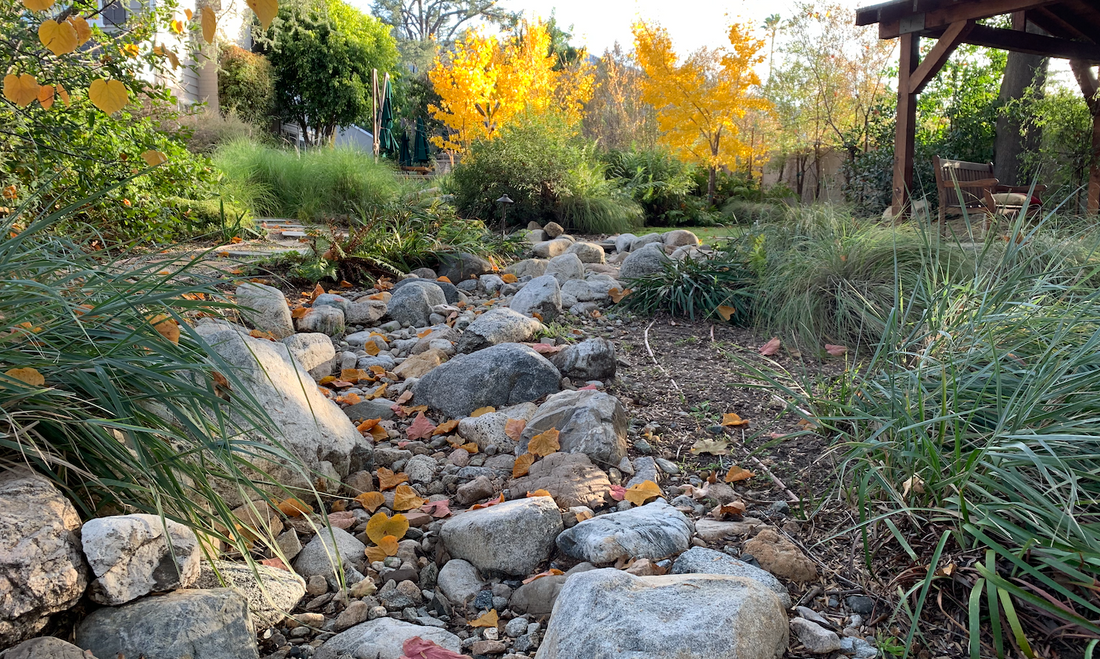There is nothing I enjoy more than replicating the natural curves and flow of a streambed in the garden. Maybe it's the Japenese garden lover in me or maybe it's the fact that natural curves serve our ecosystems SO much better than cemented straight lines.
And it's only seasonally dry. Meaning that in rain events or other types of floods, these channels flow readily, moving the water through your landscape in the direction you want it to go. And helping absorb it deeper into your garden's reserves along the way.
Regardless, collecting water and channeling it through the landscape effectively is a rewarding and important task.
Why Build a Dry Streambed?
The #1 reason to build a dry streambed in California is to collect and absorb rainwater. There may come a day - like what would've happened at the end of 2022 if the rains didn't come - where large parts of arid California won't have much water available from the water companies for landscaping. So building the resiliency into the landscape with topsoil and rainwater capture is key.
- Rainwater collection prevents erosion of our precious topsoils, valuable wildflower seeds and mulch.
- Dry streambeds greatly improve infiltration meaning more water gets deeper into the landscape and has a better chance of reaching natural underground aquifers or other types of valuable moisture storages.
- Running deep channels through the landscape provides excellent drainage for drought-tolerant plant roots, who can suffocate easily in floods.
Preventing erosion is WAY more important than a lot of people give it credit for. Did you know that healthy topsoil is actually a sponge? Good soil can store literally 100s of pounds of water in its top 6". So building its quality and protecting it is a really smart move.
"Look at it this way: with just %1 organic matter left in the topsoil...a [garden] can hold only about 33 lbs. of water per cubic meter. But if you increased that organic matter to just 5%, the soil moisture-holding capacity goes up to 195 lbs [per cubic meter]. That's nearly a sixfold difference in a [garden]'s capacity to buffer us from the effects of a drought or a flood."- Fred Kirschenmann (Nabhan's Growing Food in a Hotter Drier Climate ).
That means your soil, with healthy additions of compost and mulch can be holding almost as much water as a shallow pond IF its organic content is developed and cared for. Organic content by the way includes things like compost, worm castings, mulch (as it breaks down) and any loamy natural media.
How do you protect your topsoil? Slowing rainwater flow (or any accidental overland flow) allows your most nutrient-rich soil - which is at the top - to remain in place AND soak up the most water possible. Big rocks, logs and other natural breaks in the landscape can also provide checks to heavy flows. Add such checks on contour (sideways across any slopes at as flat an elevation as you can manage) wherever possible.
How do you add to your topsoil? Add organic matter like compost - at a significant rate, as much as can you manage without negatively effecting plants - and mulch it regularly (to 2" deep, not so much so that roots can't breath). As mulch breaks down into compost over time. Lightly till in leaf-litter and prunings instead of removing them from the landscape. Keep in mind that a lot of the most desert adapted plants, like the nitrogen-fixing Palo Verde tree prefer rock mulch or any less moist mulch layer directly over their root zone.
How to Build a Dry Stream Bed in California

The hardest part? Getting your curves just right. You want a dry stream bed to go from the highest part of your yard to the lowest on an angle that keeps the water moving as slow as possible. At the low point or end you'll need a gentle overflow that leads into a gutter/storm drain or absorption pond. Or onto a driveway if not other options exist.
Start by marking a diagonal line from the highest point of your yard down to where you want your overflow to be. Then go back and add your gentle curves from there. Putting smaller curves at the top to gradual bigger ones at the bottom for the most visual appeal. These gentle curves help to slow the water down as it moves thru the landscape. And prevent overflow.
Next dig out your curvy trench. Take it slow if your soils hard. You want to get it to at least 16" deep and wide. But you can go wider at the bottom and narrower at the top to give it that good-looking magic (the change in widths creates a trompe l'olei effect where the streambed will look much bigger from the sidewalk this way). Make your trench a bit wider where the biggest rocks lining it will go. Pile soil in gentle mounds just beyond this. Or use it to build up new slightly raised garden beds in the landscape for your most drainage-sensitive plants.
Now line & fill your trench with big rocks. Anywhere from 4"-1' in size or larger. Using a mix of sizes makes it look the most natural. Finally fill it with gravel putting tiny and small rocks on top. The gravel acts as the filter at the bottom while the slightly larger rocks keep it in place. You can use all chunky gravel for the entire fill to simplify this step. Make sure to keep your final stream beds height at least 4-6" lower than the height of the rock border at the sides.

Curious about getting help with your custom design?
Here's one of my favorite dry riverbed designs. It was added to a large private forest restoration project in Altadena that I designed back when I was starting out in custom landscape design. The dry streambed connects a flowing fountain feature at the top to a very large storm channel a long ways away at the bottom (I saw bobcats in it while working on site :D). This connection gives the visual continuity of a true water feature and channeling any overland flow ever so carefully. The large native deer and blue rye grasses love the added drainage AND shade of an old-growth sycamore.




